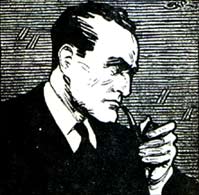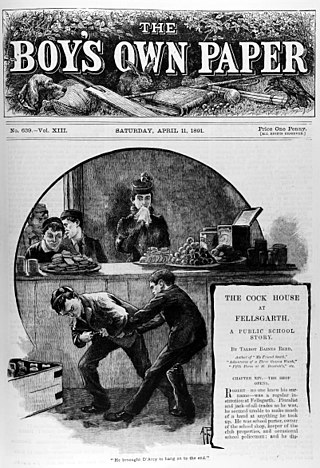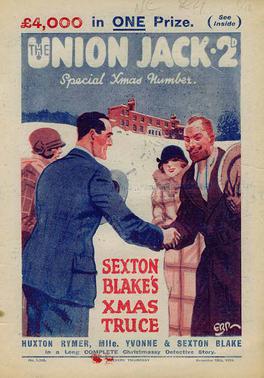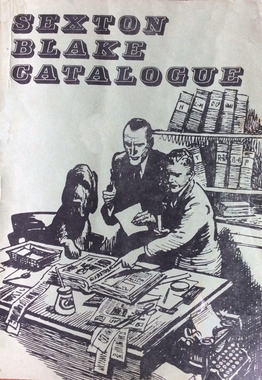
Sexton Blake is a fictional character, a detective who has been featured in many British comic strips, novels and dramatic productions since 1893. Sexton Blake adventures were featured in a wide variety of British and international publications from 1893 to 1978, comprising more than 4,000 stories by some 200 different authors. Blake was also the hero of numerous silent and sound films, radio serials, and a 1960s ITV television series.
A story paper is a periodical publication similar to a literary magazine, but featuring illustrations and text stories, and aimed towards children and teenagers. Also known in Britain as "boys' weeklies", story papers were phenomenally popular before the outbreak of the Second World War.

Valiant was a weekly British comics periodical published by Fleetway Publications and later IPC Magazines from 4 October 1962 to 16 October 1976. A boys' adventure comic, it debuted numerous memorable characters, including Captain Hurricane, The Steel Claw and Mytek the Mighty. Valiant lasted for 712 issues before being merged with stablemate Battle Picture Weekly.
Story Paper Collectors' Digest was a journal published from November 1946 until May 2005, and with special intermittent issues continuing on until late 2007. It was created by Herbert Leckenby. With articles on story papers, it heavily featured the work of Charles Hamilton, Edwy Searles Brooks and the tales of detectives Sexton Blake and Nelson Lee. It was published monthly until 2004. The editors were Herbert Leckenby until his death in October 1959, then Eric Fayne until January 1987 when he retired as editor, then Mary Cadogan.

The Union Jack was a British story paper for children of the late 19th and early 20th centuries. There were two story papers called Union Jack. The first appeared in the 1880s but was only very short-lived. The name was then used by Alfred Harmsworth in 1894 for a new halfpenny story paper intended as a companion to the successful Halfpenny Marvel.

Magazines intended for boys fall into one of three classifications. These are comics which tell the story by means of strip cartoons; story papers which have several short stories; and pulp magazines which have a single, but complete, novella in them. The latter were not for the younger child and were often detective or western in content and were generally greater in cost. Several titles were published monthly whereas the other two categories were more frequent.

Eric Robert Parker was a prolific British illustrator and comics artist best known for illustrating the adventures of Sexton Blake in various periodicals.

Knockout was a weekly British comics periodical published by Amalgamated Press and later Fleetway Publications and IPC Magazines from 4 March 1939 to 16 February 1963. A boys' adventure comic, the title ran for 1227 issues before being merged with Valiant.

George Hamilton Teed was a Canadian author who also wrote under the pen-names G. H. Teed, Hamilton Teed, Louis Brittany, Peter Kingsland, and Desmond Reid. Teed was born in Woodstock, New Brunswick. He specialized in adventure fiction and detective stories, but also wrote science fiction and the odd romance. He is best remembered for his tales of Sexton Blake, a popular, fictional British detective who featured in a wide variety of publications in the first half of the twentieth century. He wrote close to three hundred Blake tales, more than any other author, and his creations and writings are considered "the best in Blake history before the Second World War."

Nelson Lee is a fictional detective who featured in the Amalgamated Press papers over a 40-year run. Created in 1894 by Maxwell Scott he appeared in various publications including The Halfpenny Marvel, Pluck, The Boys' Friend, Boys' Realm, The Boys' Herald and the Union Jack In 1915 he was given his own story-paper series, The Nelson Lee Library, which ran until 1933.

John William Staniforth was a British writer who wrote under the pen-names Stain Cortley, John Andrews and Maxwell Scott.

Henry Thomas Blyth (1852–1898) was a British writer who also wrote under the pen-name Hal Meredith. Blyth was born in Greenwich, London. He wrote for many of Alfred Harmsworth's papers of the 1890s, and is mostly remembered for creating detective Sexton Blake.

Robert Murray Graydon was a British novelist who also wrote under the pen-names Robert Murray, Murray Hamilton, and Murray Roberts. He is best remembered for his Sexton Blake stories featuring the Criminals' Confederation, a global criminal organisation that featured prominently in the Blake magazines from 1916 to the 1930s.

William Murray Graydon was an extremely prolific American writer who also wrote under the pen-names Alfred Armitage, William Murray, and Tom Olliver. He wrote adventure, historical fiction and Sexton Blake detective stories for boy's story papers.

The Nelson Lee Library was a story paper of the first third of the 20th century, published by Amalgamated Press. It featured the adventures of private detective Nelson Lee and his boy assistant Nipper.

The Sexton Blake Library was a story paper of the first two-thirds of the 20th century, published by Amalgamated Press. It featured the adventures of private detective Sexton Blake, his boy assistant Tinker and their dog Pedro.

Sexton Blake is a fictional detective who has been featured in many British comic strips, novels, and dramatic productions since 1893. He was featured in various British publications from 1893 to 1978 in a variety of formats: single-issue adventures, short stories, serials, and comic strips. In total, Blake appeared in more than 4,000 stories by over 200 different authors. During its golden age (1920s-1940s), Blake's adventures were widely read and translated into at least twenty different languages, including Swedish, Norwegian, Finnish, Dutch, Spanish, German, Portuguese, Italian, French, Arabic, Hindi, and Afrikaans.
Sexton Blake is a fictional detective who has been featured in many British comic strips, novels, and dramatic productions since 1893. He was featured in various British publications from 1893 to 1978 in a variety of formats: single-issue adventures, short stories, serials, and comic strips. In total, Blake appeared in more than 4,000 stories by over 200 different authors.
During its golden age (1920s-1940s), Blake's adventures were widely read and translated into at least twenty different languages, including Swedish, Norwegian, Finnish, Dutch, Spanish, German, Portuguese, Italian, French, Arabic, Hindi, and Afrikaans.
Sexton Blake is a fictional detective who has been featured in many British comic strips, novels, and dramatic productions since 1893. He was featured in various British publications from 1893 to 1978 in a variety of formats: single-issue adventures, short stories, serials, and comic strips. In total, Blake appeared in more than 4,000 stories by over 200 different authors.
Sexton Blake is a fictional detective who has been featured in many British comic strips, novels, and dramatic productions since 1893. He was featured in various British publications from 1893 to 1978 in a variety of formats: single-issue adventures, short stories, serials, and comic strips. In total, Blake appeared in more than 4,000 stories by over 200 different authors.














